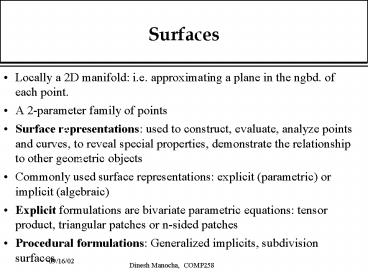Surfaces - PowerPoint PPT Presentation
Title:
Surfaces
Description:
Title: Incremental Algorithms for Collision Detection between Solid Models Madhav K. Ponamgi Dinesh Manocha Ming C. Lin Department of Computer Science University of N ... – PowerPoint PPT presentation
Number of Views:64
Avg rating:3.0/5.0
Title: Surfaces
1
Surfaces
- Locally a 2D manifold i.e. approximating a plane
in the ngbd. of each point. - A 2-parameter family of points
- Surface representations used to construct,
evaluate, analyze points and curves, to reveal
special properties, demonstrate the relationship
to other geometric objects - Commonly used surface representations explicit
(parametric) or implicit (algebraic) - Explicit formulations are bivariate parametric
equations tensor product, triangular patches or
n-sided patches - Procedural formulations Generalized implicits,
subdivision surfaces
2
Implicit Surfaces
- Implicit formulationF(x,y,z) 0, where F() is
a polynomial in x,y and z of the form - If F() is irreducible polynomial, the degree of
the surface is ijk - Geometrically the degree refers to the maximum
number of intersections any line can have the
surface (assuming finite intersections) - Any rational parametric surface can be converted
into algebraic (implicit) surface implicitization
3
Quadric Surfaces
- Given as F(x,y,z) 0, where F() is a quadratic
polynomial in x,y and z of the form - If A B C -K 1 D E F G H J
0, then it produces a unit sphere at the origin. - Also given in matrix form as P Q PT 0, where
P x y z 1
A
D
F
G
D
B
E
H
Q
F
E
C
J
G
H
J
K
4
Quadric Surfaces
- The coefficients of Q many have no direct
physical or geometric meaning - A rigid body transformation, can be directly
applied to Q as - Q T1 Q T1T
- Certain properties of the matrix of quadric
equation are invariant under rigid
transformation, including the determinants Q
and Qu,where Qu is the matrix corresponding to
the gradient (or normal) vectors
5
Parametric Surfaces
- The most common mathematical element used to
model a surface is a patch (equivalent to a
segment of spline curve). - A patch is a curve-bounded collection of points
whose coordinates are given by continuous,
bivariate, single-valued polynomials of the form
P(u,w) (x y z), where - x X(u,w) y Y(u,w) z Z(u,w),
- where the parametric variables u and w are
typically constrained to the intervals, u,w
0,1. - This generates a rectangular patch, though there
are other topological variations (e.g. triangular
or n-sided). - Fixing the value of one of the parametric
variables results in a curve on the patch in
terms of the other variable. Or generate a curve
net.
6
Parametric Surfaces Patches
- Each patch has a set of boundary conditions
associated with it - four corner points (P(0,0), P(0,1), P(1,0),
P(1,1)), - four curves defining its edges (P(u,0), P(u,1),
P(0,w), P(1,w)), - tangent vectors or planes (Pu(u,w), Pw(u,w))
- normal vectors (Pu(u,w) X Pw(u,w))
- twist vectors defined at the corner points
- In practice, composite arrays are put together or
assembled to represent complex surfaces (with
some appropriate continuity conditions at the
boundary) - Commonly used patches Hermite patch, Bezier
patch, B-spline patch (or NURBS)
7
Parametric Surfaces (NURBS) Drawbacks
- Division by zero (for the rational forms)
- Non-uniform parametrization of arcs (important in
CAD/CAM) - Many surfaces cannot be efficiently represented
as NURBS(e.g. helicoidal surfaces) - Irregular isoparametric surface meshes resulting
from the use of nonuniform weights (for the
rational forms) - Ill-conditioned basis for surface fitting
- Lack of closure under geometric operations
(composition, projection, intersection, offsets
etc.)































